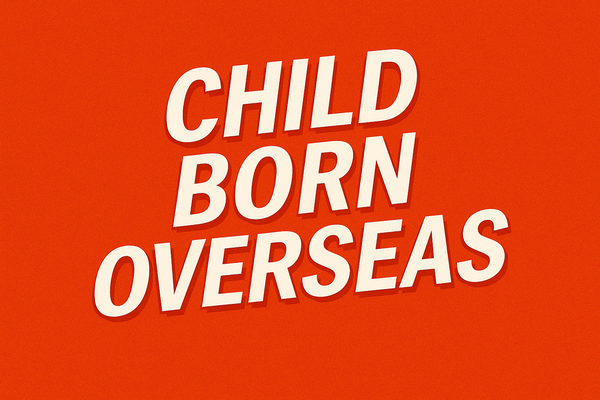Discover what to do if your child is born overseas while you’re an Australian permanent resident. Learn about visa options, requirements, and citizenship pathways.
What Happens If an Australian Permanent Resident’s Child Is Born Overseas?
Many Australian permanent residents build their families while working or studying abroad. If your child is born outside Australia, their legal status is not straightforward—unlike a child born in Australia, they do not automatically receive Australian citizenship or a visa. This guide explains your options, the steps required, and how to bring your new family member home.
Key Facts: Australian Citizenship and Children Born Overseas
No automatic citizenship or visa
If both parents are Australian permanent residents (PRs) when the child is born overseas, the child will not become an Australian citizen or receive a visa by birth. This is different from:
-
A child born in Australia to a PR/citizen parent who may acquire citizenship at birth.
-
A child born overseas to at least one Australian citizen parent, who may be eligible for citizenship by descent (with a separate application).
Steps to Bring Your Overseas-Born Child to Australia
1. Apply for a Child Visa (Subclass 101)
What does this visa do?
The Subclass 101 Child Visa is the main pathway for PRs’ children born outside Australia to join their families and start their journey toward permanent residence and citizenship.
Benefits of the Child Visa 101:
-
Allows your child to live in Australia indefinitely with you
-
Grant work and study rights
-
Enables access to public healthcare (Medicare) after arrival
-
Allows eventual application for Australian citizenship (after eligibility criteria are met)
-
Opportunity to sponsor relatives and apply for other benefits, if eligible
Key eligibility requirements:
-
The child must be outside Australia when you apply
-
Must be under 18 years old (or under 25 if they are financially dependent and a full-time student)
-
Must be sponsored by a parent who is an Australian permanent resident or citizen
-
The child cannot be married, engaged, or in a de facto relationship
Tips:
Prepare documents such as birth certificates, passports, and evidence of parental status and relationship. Carefully check all requirements for accuracy and completeness.
2. If Parents Hold Temporary Visas
If neither parent is a PR or citizen (e.g., both are on temporary visas), your child can be:
-
Added as a dependent to your own resident visa application, or
-
Apply for an appropriate child or dependent visa tailored to your family’s situation
Visa types, conditions, and documentation will vary. Seek updated guidance for the most accurate advice.
Important Considerations for Parents
No citizenship by descent if parents are PRs only:
This route is only available if at least one parent was an Australian citizen at the time of the child’s birth. Permanent residency alone does not grant this benefit.
Processing times:
The child visa (Subclass 101) assessment can take 21–27 months due to high demand and administrative backlogs. Plan your timeline accordingly and ensure your documentation is mistake-free to avoid additional delays.
Urgent travel solution:
If you need to enter Australia while the child’s visa is processing, you can consider applying for a Visitor Visa (Subclass 600) for them. Note this does not guarantee approval and carries the usual conditions of a tourist visa.
Medicare and Access to Healthcare
After your child’s permanent residency is granted and upon arrival, they are typically eligible for Australia’s public healthcare scheme, Medicare. Check enrolment requirements based on your time spent overseas and whether you are re-enrolling as a family.
If you are a PR returning after less than 12 months abroad:
-
Lodge a Medicare enrolment form for your child
-
Provide passport, birth certificate, and evidence of PR application/visa grant
If abroad for more than 12 months:
-
Both parents (s) and the child must enrol again
-
Provide additional evidence of current Australian residence
Special Cases
Adopted children:
Special adoption and child visa pathways (e.g., subclass 102) may apply if the child was legally adopted overseas. Requirements depend on each parent’s immigration status at the time of adoption.
If one parent is an Australian citizen:
Apply for citizenship by descent for your child. Once approved, your child becomes an Australian citizen and is eligible for an Australian passport.
Summary Table of Pathways
| Parent’s Status | Child Born Overseas – Next Steps |
|---|---|
| Australian Citizen | Apply for citizenship by descent |
| Australian Permanent Resident | Apply for Subclass 101 Child Visa |
| Temporary Visa Holder | Add a child as a dependent on a parent’s visa, or another visa |
Conclusion:
If you’re an Australian PR with a child born overseas, you must plan ahead to secure the right visa. Early preparation, accurate paperwork, and awareness of processing times will help your whole family start your life in Australia smoothly and legally. Consider professional advice for complex or unique cases.

